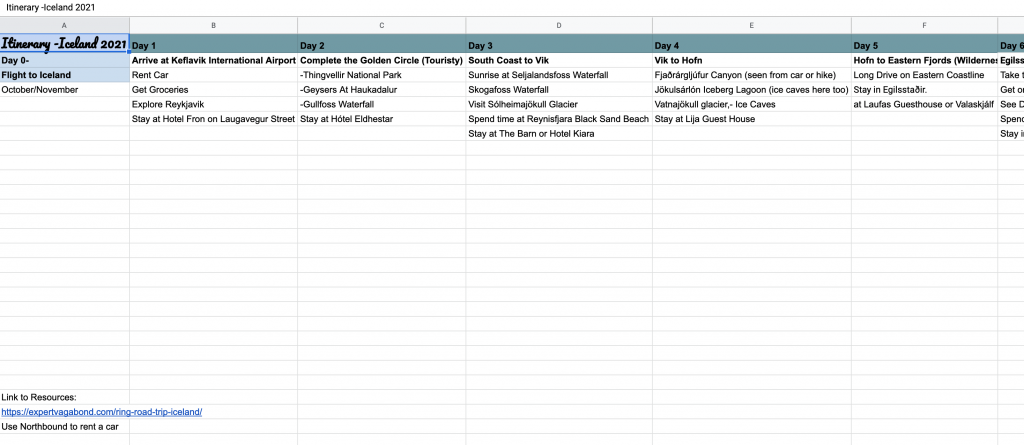Dreaming of your next trip? So are we. We travel regularly, and this is only made possible by creating a travel budget. Below I’m sharing exactly how to budget your trip so you can actually enjoy your travel instead of worrying about how you’re going to afford it.
How to Budget Your Trip in 7 Steps
This is exactly how to plan and budget your trip in 7 simple steps.
1. Choose Your Destination
Time to pick where you are going. This is the fun part. We will typically have YouTube sessions filled with searches like “The Most Remote Places in the World” or “Places You Need to See Before You Can’t”.
Keep in mind the destination will determine the cost of the trip. So if you don’t have much time to save or you want to limit how much you spend, look for a destination that is cheaper. If you’re planning to leave the country, review the exchange rate of your currency for the country you plan to visit. This will tell you how far your money can stretch on your next trip.
Of course, you may already have your dream destination picked out, so it is time for the next step.
2. Begin Your Research for Your Destination
This step is essential. While Iceland may be your destination of choice, you need to start digging into the details such as:
- ‘Must-see’ locations. We start by looking at UNESCO World Heritage Sites in our destination.
- Housing and lodging options. Are you going to stay in luxury hotels, hostels, rent a camper van, or stay in your tent.
- Transportation options. Does the city have a good subway you can access? Will you be able to get around on foot or do you need to rent a car?
- Food accommodations. While we almost always throw our diet out the window when we travel, I am allergic to dairy so I still need to consider the local menu and do some research for dishes that won’t make me sick. (Did you know Ratatouille is Vegan?) Knowing those food allergies may make a trip more costly or mean you need a way to cook for yourself.
- Travel dates. We always try to travel in the offseason, which can vary by destination. Traveling in the offseason means you save money, but it also means the weather could be off-putting. Research the best time of year to be in your destination and the off-season when fewer tourists will be there. See if some of the dates overlap and aim for those.
- Checking for travel restrictions. You want to be sure you can get around in your destination of choice and that no travel ban is in place. For example, when I went to Italy and Greece, I had also planned to stop over in Turkey. This was quickly changed due to political unrest and a temporary warning for tourists to be wary of coming into the country.
3. Nail Down the Details so You Can Budget Your Trip
Once you have done the research, it is time to nail down the details. You need to know:
- How many days you plan to be gone
- Flying time
- Activities
- Food and dining
- Where you will stay
I write all of this out on a spreadsheet to keep track. Here is an example from Peru and Iceland.


4. Estimate The Cost for Your Trip
This is the most important step to budget your trip. You need to have an educated guess of how much everything will cost. This should be easy now that you have done your research and know your travel details. Add the cost to the spreadsheet or notes you made for your trip.
5. Subtract Any ‘Free Travel’ From Cost
If you are like us and use travel credit cards as a way to make travel less expensive then this is when you would subtract your points and perks from your total trip budget. For example, if you plan to fly using all of your Chase Ultimate Rewards Points and only pay for taxes and fees, this could make your trip budget much less taxing on your regular monthly budget.
6. Start Automating Your Savings for the Trip
You have a number! Hooray. Now the key to budgeting your trip successfully is to automate your savings. To figure out how much you need to save use this simple formula:
Total Cost of Trip/ Number of Months Till You Leave

7. Track Your Saving in Your Budget
You will want to track your trip budget because you may need to book items during your saving period. For example, you may need to purchase your flights several months prior to the trip. Keeping track of how much you have saved so far will help you stay on budget for your trip.
You Can Budget Your Trip No Matter Where You Plan to Go
This is the budgeting method we use every time we plan a major trip out of our state. We have successfully saved for three major out of the country trips this way- without going over our budget. No matter where you go- take these steps and budget for your trip now so you can enjoy every minute of it when the time arrives.

1 comment
Ah, travel – how I miss you!
I do roughly the same too (without the spreadsheet! I use a notebook to jot down all my research). I also have a sinking fund – name it Travel – and save a weekly amount. It’s been nice watching it grow this year but I’m afraid I will blow it all in one go when travel bans lift in Australia!